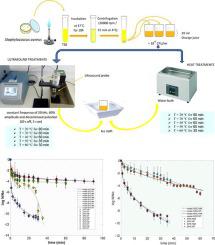Ultrasonics Sonochemistry ( IF 8.7 ) Pub Date : 2021-09-07 , DOI: 10.1016/j.ultsonch.2021.105743 Akila Amir Tahi 1 , Sérgio Sousa 2 , Khodir Madani 3 , Cristina L M Silva 2 , Fátima A Miller 2

|
Ultrasounds are being considered an excellent alternative technology in juice preservation. Yet, when combined with heat treatment, the process seems to be further intensified. This work aimed to evaluate and compare the impact of ultrasounds and heat treatments, when applied alone or in combination, on Staphylococcus aureus survival in orange juice. Inoculated commercial pasteurized orange juice was treated at different times at 20, 30, 40, 50 and 60 °C. SEM analyses were applied to identify morphological changes in S. aureus cells appearance. The microbial inactivation data were fitted using two mathematical models, depending on the behaviour observed.
Sonication at 20, 30, and 40 °C induced 4.02 ± 0.52, 3.80 ± 0.49 and 4.30 ± 0.74 log cycles reduction of S. aureus after treatments of 90, 60 and 60 min, respectively. The heat treatments at the same temperatures had no impact on S. aureus survival. When 50 and 60 °C were applied, more than 5-log reductions were attained for both thermosonication and heat treatments alone. A synergistic effect was observed between sonication and high temperatures. At 50 °C, the thermosonication reduced the treatment time from 60 to 35 min and the microbial load from 5.14 ± 0.08 to 10.76 ± 0.28 log cycles reduction, compared to heat treatment alone. Results from SEM images showed that cells undergo membrane damage during sonication exposure. This was observed by collapsed cells, cell disruption, and holes in the cell’s membrane.
Thermosonication proved to be a viable alternative to thermal pasteurization of orange juice since milder treatments can be safely applied, improving the final product quality.
中文翻译:

超声波和热处理对橙汁中金黄色葡萄球菌细胞活力的影响
超声波被认为是果汁保存的绝佳替代技术。然而,当与热处理相结合时,该过程似乎会进一步强化。这项工作旨在评估和比较超声波和热处理单独或组合应用时对橙汁中金黄色葡萄球菌存活的影响。接种的商业巴氏灭菌橙汁在 20、30、40、50 和 60°C 的不同时间进行处理。应用 SEM 分析来鉴定金黄色葡萄球菌细胞外观的形态变化。根据观察到的行为,使用两个数学模型拟合微生物灭活数据。
处理 90 分钟、60 分钟和 60 分钟后,20、30 和 40 °C 下的超声处理分别诱导金黄色葡萄球菌减少 4.02 ± 0.52、3.80 ± 0.49 和 4.30 ± 0.74 个对数周期。相同温度下的热处理对金黄色葡萄球菌的存活没有影响。当应用 50 和 60 °C 时,仅热超声处理和热处理即可实现超过 5 个对数的减少。观察到超声处理和高温之间的协同效应。与单独热处理相比,在 50 °C 下,热超声处理将处理时间从 60 分钟缩短至 35 分钟,微生物负荷从 5.14 ± 0.08 减少到 10.76 ± 0.28 个对数循环。 SEM 图像的结果表明,细胞在超声处理过程中会遭受膜损伤。这是通过细胞塌陷、细胞破裂和细胞膜上的孔洞观察到的。
热超声处理被证明是橙汁热巴氏灭菌的可行替代方案,因为可以安全地应用更温和的处理,从而提高最终产品的质量。











































 京公网安备 11010802027423号
京公网安备 11010802027423号